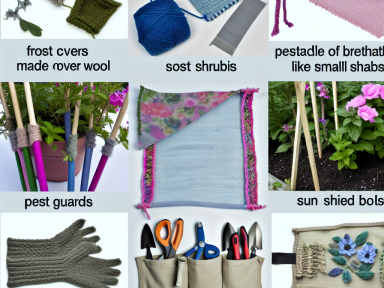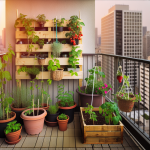Exploring the Symbiosis Between Knitting, Sewing, and Gardening
Many might see knitting and sewing as indoor hobbies that contrast with the outdoor nature of gardening. However, these crafts can complement your green-thumbed pursuits exceptionally well.
Creating Protective Plant Covers
Knitting and sewing provide an excellent opportunity to create customized protective covers for your plants. These covers serve multiple purposes including protecting against frost, pests, and excessive sunlight.
- Frost Covers: Use wool or thicker yarn to knit or crochet plant cozies for small shrubs or young trees. The natural insulation properties of wool can protect tender plants from an unexpected early frost.
- Pest Guards: Lightweight, breathable fabrics like muslin or fine netting can be sewn into custom-fit plant covers. These can keep out insects while allowing light and air to reach your plants.
- Sun Shields: For plants that require shade during peak sun hours, sew larger panels using UV-resistant fabric. These can be draped over garden stakes to create effective and durable sun shields.
Crafting Plant Ties and Supports
Both knitting and sewing can help you create an array of plant ties and supports that are both functional and decorative.
- Knitted Plant Ties: Soft yarn or even old t-shirt yarn can be knitted into flexible yet strong plant ties. These are gentle on delicate stems and can be adjusted as the plant grows.
- Fabric Plant Supports: Use sturdy fabrics like canvas or denim to sew strips that can be used as plant supports. These are particularly useful for climbing plants and tomatoes. Reinforce these strips at stress points to ensure they can withstand weight and weather.
Custom Garden Tool Holders
Gardening involves a fair amount of tools and accessories. Knitting and sewing offer a method to create custom holders to keep everything organized and easily accessible.
- Knitted Tool Pockets: Use heavy-duty yarn to knit pockets that can be attached to a gardening belt. This keeps essential tools like pruners and trowels within reach.
- Sewn Tool Aprons: Design and sew a garden apron with numerous pockets for various tools. Include reinforced sections for heavier tools and smaller compartments for seeds and markers.
Upcycled Gardening Accessories
Old knitwear and fabric scraps can be repurposed into valuable gardening accessories, contributing to eco-friendly practices.
- DIY Seed Bags: Use remnants of fabric to sew small pouches for seed storage. These are not only practical but also reduce plastic usage. Consider adding labels or color-coding them for different plant species.
- Knit Plant Markers: Not everyone knows that yarn scraps can be knitted into tiny flags or markers. These can be color-coded to signify different plant types or growth stages. Simply attach them to wooden stakes or metal rods and place them in your garden beds.
Final Thoughts
The intersection of knitting, sewing, and gardening presents a unique opportunity to enhance both your crafting and gardening skills. By creating personalized, functional items for your garden, you not only improve plant care but also add a touch of creativity to your gardening routine.




GIPHY App Key not set. Please check settings